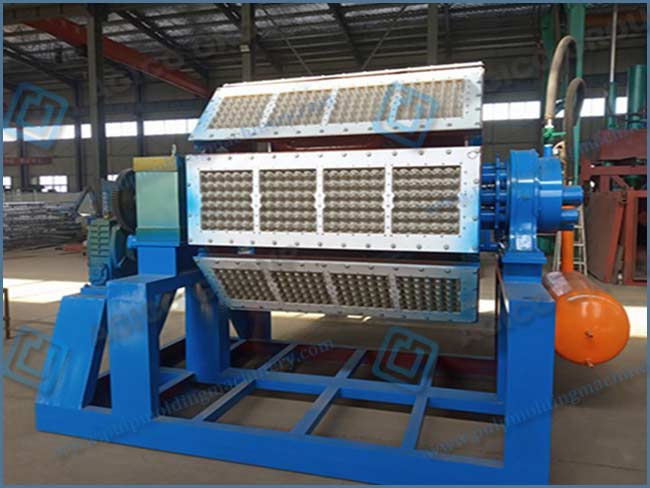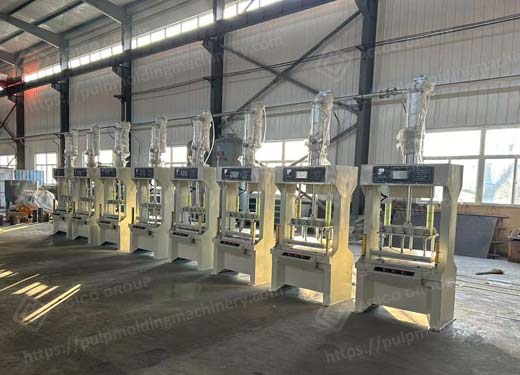Pulp Molding Process
The finished pulp goes to the molding machine to form trays. At the same time, excess water was sucked away through vacuum water air separator tank and stored in water tank. In addition to regular plastic molds, the mold material can be customized to aluminum. The molds can also be customized based on different final products like egg boxes, coffee cup trays, apple trays, shoe stretches, etc. Wet trays were blew from the forming mold to the transfer mold and passed into dryer.
- Pulp Delivery:The prepared, finished pulp slurry is pumped or conveyed into the molding machine.
- Forming on the Mold:Inside the molding machine, the pulp slurry is deposited onto or drawn onto a forming mold. This mold defines the shape of the final product (e.g., an egg box, coffee cup tray, apple tray, shoe stretcher).
- Water Removal (Vacuum De-watering):As the pulp conforms to the mold shape, a powerful vacuum is applied. This vacuum suction pulls excess water out of the wet pulp mat. The extracted water passes through a vacuum water air separator tank, which separates the water from the air used in the vacuum system.
- Water Recovery:The separated water is collected and stored in a water tank for potential recycling and reuse within the process, promoting efficiency and reducing water consumption.
- Mold Release:Once sufficient water is removed and the wet product (e.g., a tray) holds its shape on the forming mold, it needs to be transferred. Compressed air is used to blow the wet tray off the forming mold surface.
- Transfer:The blown wet product is moved onto a transfer mold. This mold typically has a matching shape to support the fragile wet product during movement to the next stage.
Q1: What is the core function of the pulp molding machine?
A: Its core function is to form the finished pulp slurry into specific 3D shapes (like trays or boxes). This involves depositing the pulp onto a forming mold and using vacuum suction to rapidly remove water, creating a coherent wet product.
Q2: How is water removed during the molding step?
A: A powerful vacuum is applied through the forming mold. This suction pulls water out of the pulp as it conforms to the mold shape. The extracted water and air mixture passes through a Vacuum Water Air Separator Tank. Here, the water is separated from the air. The separated water is stored in a water tank for potential reuse.
Q3: What materials are the forming molds typically made from?
A: While regular plastic molds are common, molds can also be customized to aluminum. Aluminum molds offer advantages like higher durability, better heat transfer, and finer detail for specific applications.
Q4: Can the molding process create different products?
A: Yes, absolutely. The key to product variation is customizing the forming mold. The mold’s shape and design are specifically engineered based on the desired final product, such as egg boxes, coffee cup trays, apple trays, or shoe stretchers.
Q5: How is the wet product removed from the forming mold?
A: Once dewatered sufficiently to hold its shape, compressed air is used to blow the wet product (e.g., a tray) off the forming mold’s surface. This is a critical step to release the fragile wet shape without damage.
Q6: What happens to the wet product after it’s blown off the forming mold?
A: The blown wet product is transferred onto a transfer mold. This transfer mold typically has a matching shape to support the wet product and carries it into the dryer for the next stage of processing (drying is not part of the molding step itself).

